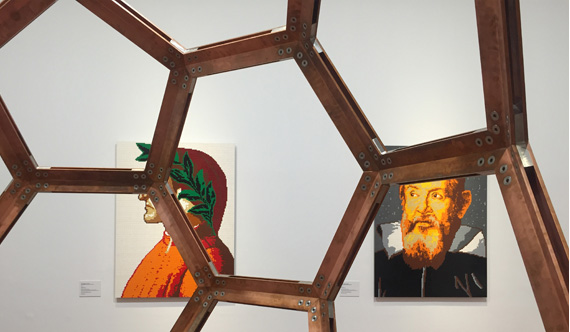Icosaedro
ICOSAHEDRON by Promemoria
Geometric solids, from philosophical speculation to technological application
During the Milan Design week, ICOSAEDRO, an example of Italian technological innovation and style, will be exhibited in BIG - Borsa Italiana Gallery.
For Promemoria, light is not just synonymous with beauty, serenity, balance and happiness, but also an opportunity for constant technological innovation.Thus ICOSAEDRO was born. A lighting system developed over a period of three years, a system which is now patented.
The idea was born from the need to replace the traditional incandescent light source with one with a low energy consumption but with a wide light emission close to 360°as with a traditional light bulb.
FREE ENTRANCE EXHIBITION
3rd April 2017: 14,30-19,00
4th- 7th April 2017: ore 10,30-19,00
Palazzo Mezzanotte, Piazza degli Affari 6 Milan

Curated by Francesca Pini
The fascination for Platonic solids, including cosmological, has ancient roots. Through the centuries it has concerned philosophers, mathematicians, mystics and artists who have searched for and seen beauty, perfection and even god’s creation in these three-dimensional shapes.
It was Plato (cIV BC) in particular who was most thorough in his reflections as demonstrated by his work Timaeus, in which he cites the contributions of Pythagoras (cVI BC) who before Plato himself, studied the cube and the tetrahedron. Meanwhile the study of the octahedron and the icosahedron (a shape formed of twenty equilateral triangles, twelve apexes and thirty sides) dates back to the Athenian Theaetetus (a contemporary of Plato) whose research was acknowledged by Euclid of Alexandria (beginning of cIII BC) and re-elaborated in the XIII book of the Elements.
Archimedes studied not only regular polyhedrons but also semi-regular ones. To each platonic solid as described by Timaeus a fundamental element of the universe was assigned. In the case of the icosahedron, it was water. Here however in this room, we see it assigned to something different, to something immaterial; to light (warm LED light). By joining the apexes of one side of the icosahedron with the centre of the solid, you get the image of isosceles triangle just like one of the faces of the Cheops pyramid in Egypt. Furthermore, the icosahedron needs to be viewed in strict relation with its golden ratio: a mathematical expression (used by architects and painters) signifying beauty and harmony, attributes which the dodecahedron (the maximum expression of the Universe and of divinity according to Plato) abounds in.
Throughout time, the regular polyhedron has been amply studied. During the Renaissance period, the architect Leon Battista Alberti and the painter Piero della Francesca in his treatise De quinque corporibus regularibus, were particularly active, considering it as a model of perfection. The pinnacle of study and representation occurred with the publication in 1509 in Venice of the book De Divina Proportione, edited by Luca Pacioli in 1498. An extraordinary manuscript illustrated with 60 solids (full and empty) drawn by the expert hand of Leonardo da Vinci and donated to Ludovico il Moro, Duke of Milan. Pacioli’s book was so profound for the culture of its time that the painter Jacopo de’ Barbari painted the monk together with all his mathematical instruments while he traced a form on the blackboard, then projected it into the air in its three dimensional shape.
Further essays about platonic solids were written in the 17th century by Kepler and Cartesius. Today we can see how contemporary artists like Ai Weiwei in his recent exhibition at Palazzo Strozzi in Florence has faced this very same theme by creating a vacuous structure inspired by one of these platonic solids.
EXHIBITIONS' CALENDAR
Rest on the Flight into Egypt
from 2 November 2017 to 30 January 2018 - by invitation only
ARCHIVE
Panorama by Altagamma
from 5 September to 8 September 2017 - free entrance
Rivelazioni - The restored artworks
Pinacoteca di Brera collection
from 17 April to 31 July 2017 - by invitation only
ICOSAHEDRON by Promemoria
from 3 to 7 April 2017 - free entrance
Le Jour, Concetto Spaziale, 1962
Lucio Fontana
from 20 to 31 March 2017 - by invitation only
